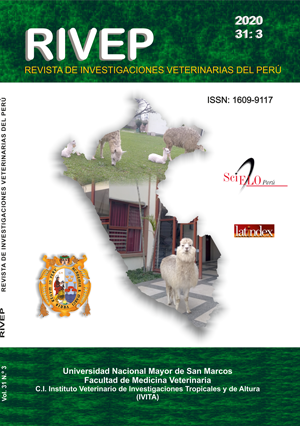Comparación de indicadores autoecológicos en dinámica de crecimiento de Festuca dolichophylla (Presl, 1830) y Festuca humilior (Nees & Meyen, 1841)
DOI:
https://doi.org/10.15381/rivep.v31i3.18743Palabras clave:
biomasa, comportamiento hídrico, macollos, pajonales, transpiraciónResumen
El objetivo del estudio fue comparar el crecimiento, acumulación de biomasa, dinámica de macollamiento y comportamiento hídrico de Festuca dolichophylla (Presl, 1830) (fedo) y Festuca humilior (Nees & Meyen, 1841) (fehu). El estudio se realizó en pajonales de condición buena en la sierra peruana a una altitud de 4186 msnm. Se utilizó un modelo con efectos fijos: especie y mes, y un efecto aleatorio: edad pos-plantación. fedo evidenció mayor altura a la hoja bandera con 29.66±0.56 cm y volumen de mata con 993.88±44.34 cm3, en tanto que fehu evidenció una mayor proporción de floración con 35.71±1.84%. Ambas especies tuvieron similar cantidad de macollos basales. En marzo-2016 se evidenció el pico más alto de humedad volumétrica del suelo (20 cm) con 57.37±0.78%, mientras que en setiembre-2016 fue el pico más bajo con 13.86±0.83%. En diciembre de 2016 se evidenciaron los picos más altos de transpiración con 92-95 mmol m2- s-1, mientras el pico más bajo fue en julio-2016 con 24-27 mmol m2- s-1. El mayor crecimiento y acumulación de biomasa lo tuvo fedo, posiblemente debido a que su estrategia adaptativa es la ocupación del espacio. La mayor proporción de floración lo tuvo fehu, donde posiblemente la floración persistente sea su estrategia adaptativa. La tasa de transpiración en fedo y fehu fueron similares y menores a otras especies en pajonales semiáridos, demostrando ser más eficientes en la estrategia adaptativa del uso del agua.
Descargas
Descargas
Publicado
Número
Sección
Licencia
Derechos de autor 2020 Fritz Carlos Trillo Zárate, Jimny Nuñez Delgado, Lucrecia Aguirre Terrazas, Cecilio Antonio Barrantes Campos, Enrique Flores Mariazza

Esta obra está bajo una licencia internacional Creative Commons Atribución-NoComercial-CompartirIgual 4.0.
LOS AUTORES RETIENEN SUS DERECHOS:
a. Los autores retienen sus derechos de marca y patente, y tambien sobre cualquier proceso o procedimiento descrito en el artículo.
b. Los autores retienen el derecho de compartir, copiar, distribuir, ejecutar y comunicar públicamente el articulo publicado en la Revista de Investigaciones Veterinarias del Perú (RIVEP)(por ejemplo, colocarlo en un repositorio institucional o publicarlo en un libro), con un reconocimiento de su publicación inicial en la Revista de Investigaciones Veterinarias del Perú (RIVEP).
c. Los autores retienen el derecho a hacer una posterior publicación de su trabajo, de utilizar el artículo o cualquier parte de aquel (por ejemplo: una compilación de sus trabajos, notas para conferencias, tesis, o para un libro), siempre que indiquen la fuente de publicación (autores del trabajo, revista, volumen, numero y fecha).



